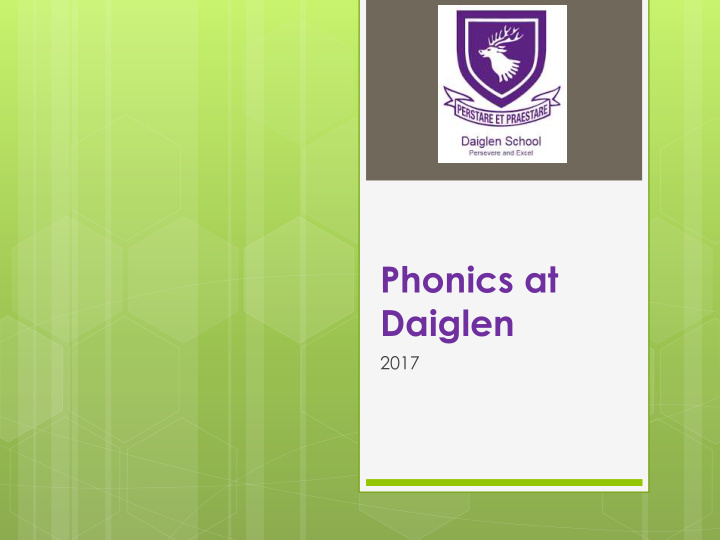



Phonics at Daiglen 2017
Early Phonics Phonological awareness is developed from birth and is the ability to register, rehearse and categorise the sounds of language. IT IS CRUCIAL THAT CHILDREN HAVE AS MANY OPPORTUNITIES FOR EARLY PLAY WITH LANGUAGE AND RHYME AS POSSIBLE. Children need to develop: Awareness of words as units of sound Awareness of syllables in words Appreciation and enjoyment of rhythm and rhyme Awareness of onset and rime
Research has shown… Early sound play essential for chdn at risk of later literacy difficulties Chdn who know a lot of nursery rhymes generally will read well Chdn read to regularly have a wide vocabulary and strong comprehension skills later on Chdn with a good sense of beat develop good reading and writing skills Physical development and early writing linked
Phase 1 Phase 1 in a nutshell: Working on: Showing awareness of rhyme and alliteration, distinguishing between different sounds in the environment and phonemes, exploring and experimenting with sounds and words and discriminating speech sounds in words. Beginning to orally blend and segment phonemes. This is the foundation upon which phonics skills are built.
Phase 2 Phase 2 in a nutshell: Working on: Using common consonants and vowels Blending for reading and segmenting for spelling simple CVC words. Working on: Knowing that words are constructed from phonemes and that phonemes are represented by graphemes. Letter progression: Set 5: h, b, f, ff, l, ll, ss Set 4: ck, e, u, r Set 3: g, o, c, k Set 2: i, n, m, d Set 1: s, a, t, p
Phase 1 It is crucial that children have experienced Phase 1 before moving on to phase 2. (Inability to do all of phase aspects does not prevent moving on to phase 2 ) Phase 1 must be continuous throughout phases 2- 6. Children should be encouraged to orally blend and segment phonemes before writing them. We must discern between phonics and letter formation. Writing should not distract from phonics. Only when the child is ready should the two be put together. We develop motor skills throughout Nursery.
Phase 1 – rhythm and rhyme: useful ideas Showing an awareness of different phonemes. Developing vocabulary. Motor Skills Distinguishing difference in volume Mouth shapes to form phonemes – mirrors! Differentiation (bat/spider) Beat and rhythm Alliteration and onomatopoeia Call and response Discriminating pictures from print for meaning
Awareness of beat is necessary before segmenting and blending can take place Music and rhyme can help with this. Nursery Rhymes can be acted out. Children can clap the beat or words, songs and rhymes.
Phase 1 – environmental sounds Go on environmental sounds walks Sound quiz – pictoral sorting of sound types, volumes, pitches Sound lotto Hunt the thimble – high and low volumes Treasure map of sounds
Instrumental Sounds Here’s the tambor …(to the tune of London’s Burning) - make a sound – describe it- make the opposite – vary volume Building up descriptive vocabulary Add the sound effects to a book E.g. Instrumental sounds text:
Body Percussion Record your own sound track Call backs to develop listening skills – call and response Go beyond clapping
Alliteration Chdn must hear and say words first; linking to the grapheme 2 nd . In Nursery there will be weekly displays of each child’s name with items brought in that begin with the same sound, as a homework task for each child during the year.
Voice Sounds Chdn must warm up facial muscles akin to fine motor skills warm up. Mirrors situated around the room – annunciate carefully! What the Ladybird Heard – make maps, give each child an animal to enact (alliterative human names)
ORAL Blending and Segmenting This MUST be left until children are ready. Blending 1 st , then segmenting. Magic River (can I cross your magic river?) Only if you have a g – oa-t. What do you need? Find goat picture. Only if you have a c-u-p. Differentiation: If chdn unable to segment, model it and invite to repeat - back. - If chdn are more able, go to 3 sounds or 4. -
ORAL Blending and Segmenting Make monsters based on book Feed segmented words Decide if he likes foods Shopping Lists Lunch menu Chdn must be clear that blending is to help with reading Integrate with a book – adult reading, but may highlight 2/3 relevant words each time so as not to interrupt story’s flow.
Challenging Vocabulary

Recommend
More recommend